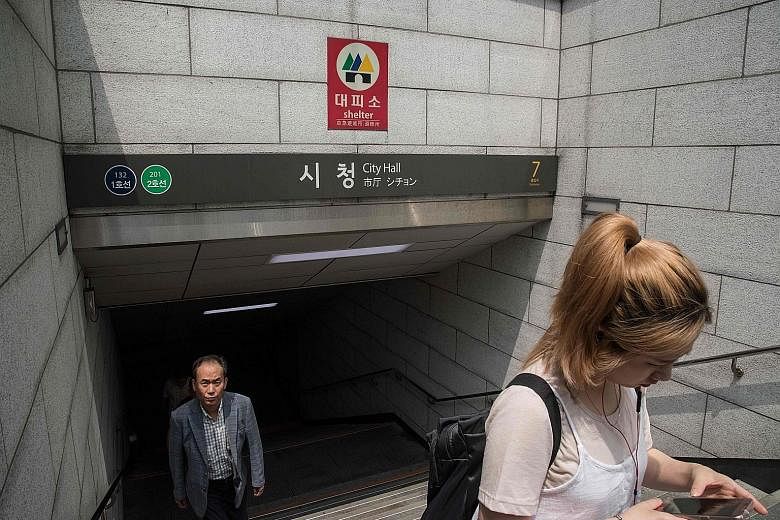SEOUL • Long within reach of most conventional North Korean artillery and missiles, South Korea and Japan are far from prepared if an all-out military conflict breaks out as tensions escalate over Pyongyang's rapidly advancing nuclear weapons programme.
The US said this week it was ready to use force if necessary to counter the threat from North Korea, which tested an intercontinental ballistic missile that some experts believe has the range to reach Alaska and Hawaii, and perhaps the US Pacific North-west.
North Korea often threatens to strike the neighbouring South and Japan, vowing to turn Seoul into a "sea of fire" and "a pile of ashes" the moment it has an order from leader Kim Jong Un.
South Korea has nearly 19,000 bomb shelters throughout the country. They include more than 3,200 in Seoul, just 40km from the militarised border drawn up under a truce that stopped the 1950-53 Korean War but left the combatants technically at war.
In Seoul, university student Chung Yoon Jin had no clue these shelters existed. "I have never seen any signs that say 'shelter', although I have been to lots of places in Seoul," the 26-year-old said.
The shelters are not built to protect against nuclear, chemical or biological attacks. They are mostly in subway stations or basements and parking garages in private apartments and commercial buildings designated as shelters.
-
19,000
Approximate number of bomb shelters across South Korea
-
3,200
Approximate number of shelters in Seoul alone
In Seoul, most bomb shelters have no long-term supplies of food, water, medical kits or gas masks, an official at Seoul Metropolitan Government told Reuters. They cannot be forced to stock up as no public funding is provided, said the official who declined to be identified.
In Tokyo, the Japanese capital of 13.5 million people has an unknown number of bomb shelters left from World War II, but they are not usable or accessible to the public, an official at Tokyo Metropolitan Government's disaster prevention department told Reuters.
Tokyo has no plans to reuse the decades-old shelters or build new ones for now. "The extent of any damage that could be caused by a North Korean missile is still unknown, and it will take time to figure out an appropriate design for a shelter," the official said.
Unlike in Japan, where sales of private nuclear shelters and radiation-blocking air purifiers have risen in recent months, South Korea has no market for private bunkers. One public bomb shelter that Reuters visited in central Seoul was in a large underground parking garage a few steps from a government complex building. A small sign posted at the entrance indicated a shelter, but people inside had no clue.
A person in charge of the parking garage said one day last year, he entered the office and saw a "shelter" sign posted, but he had no idea what it was. To raise awareness, Seoul has handed out 34,000 paper fans this summer with information about bomb shelters, and is in the process of creating other promotional products the city government official said.
REUTERS

